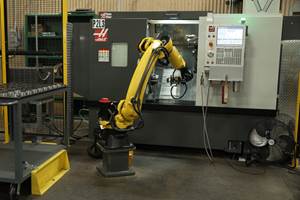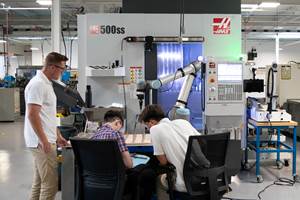Lights-Out Machining Gets Company Off To A Profitable Start
When Paul Brooke formed PZ Engineering (West Yorkshire, United Kingdom) in 2003, he immediately realized that lights-out, unattended machining would be an essential component of creating a viable company. He was also searching to equip his shop with machines from manufacturers that could provide local, responsive support.
Share






When Paul Brooke formed PZ Engineering (West Yorkshire, United Kingdom) in 2003, he immediately realized that lights-out, unattended machining would be an essential component of creating a viable company. He was also searching to equip his shop with machines from manufacturers that could provide local, responsive support.
Given ColchesterÔÇÖs Lathes offering of Storm series lathesÔÇöavailable in the United States through Clausing Industrial Inc. (Kalamazoo, Michigan)ÔÇöand the close proximity of ColchesterÔÇÖs manufacturing plant, Mr. Brooke says that his basic concerns were answered. In addition, various packages were available to finance the machinesÔÇöan attractive option for a one-person start-up company.
ÔÇťI needed assurance that the machine I was to initially invest inÔÇöa Storm 220M with driven toolsÔÇönot only met my budget, but was also reliable,ÔÇŁ says Mr. Brooke. ÔÇťOf course, the machine had to be capable of accommodating virtually any job I had to produce as well.ÔÇŁ
Mr. Brooke emphasizes that the livelihood of his company essentially depended on the machine and the relative service support. Two years, three employees and four additional Colchester CNC machines later, Mr. Brooke is pleased with his initial decision.
Supplying valve industry components of various materials to a mainly local customer base in batch quantities varying from four to 18,000, PZ says it relies heavily on its trio of Storms, two 220M three-axis slant-bed CNC lathes and the latest acquisition, a Colchester five-axis T6MS mill/turn chucking center with subspindle. Two of the machines feature Storm MBF integrated 1000 bar feeds, which Mr. Brooke says he has found to be useful.
Like many people who run small engineering companies, Mr. Brooke spends a considerable amount of time dealing with business issues and company administration.
ÔÇťHaving two bar-fed lathes running regularly throughout the night with no one around enables me to cost-effectively produce large batches,ÔÇŁ Mr. Brooke explains. He sets up all of the machines himself, performing the programming on the shop floor. ÔÇťWhen I return in the morning, the components are ready to be loaded onto the vertical machining centers for finishing/secondary operations.ÔÇŁ
Just last year, PZ added the five-axis Colchester T6MS turning center with a subspindle and one-hit milling and turning capability. Mr. Brooke describes this as being a critical move in enabling him to reduce cycle and leadtimes in the production of finished parts directly from the machine.
ÔÇťIn one instance involving a typical valve industry part, the 40-mm long component is produced on the T6MS in a fraction of the time customarily required when involving a sequence of main spindle rough turning, center drilling, finish turning, boring, threading, tapping and parting-off,ÔÇŁ says Mr. Brooke.
With a maximum part length capacity of 450 mm between spindles, PZ takes advantage of the machineÔÇÖs capability for in-phase radial C-axis rotation to enable in-cycle synchronized spindle ÔÇśkissingÔÇÖ at 30 m/min for ÔÇśon-the-flyÔÇÖ part exchange. The 12-station, all-driven, 3.7-kW, 30 VDI mill/turn turret services both spindles controlled by the Fanuc 18i-TB CNC, and it can maintain a positional accuracy to +0.005 mm, with repeatability within +0.002 mm. The part is then transferred to the subspindle, where rough turning, grooving and finish turning are performed.
The Colchester ÔÇślights-outÔÇÖ package includes a bar feed and swarf conveyor, axis tool monitoring and sister tool replacement and production scheduling software. In-process gaging using Renishaw probes is also included to provide automatic off-set adjustment. Available as a ready-to-turn package, the T6MS has 52-mm bar capacity, and the main spindle is powered by 15-kW, 6,000 revs/min motor with a 5.5-kW, 6,000 revs/min subspindle.
Along with two vertical machining centers, the T6MS complements the existing pair of Storm 220Ms. These machines have larger 65-mm bar capacities, over-the-bed swings of 510 mm and maximum turning capacities of 260 mm by 540 mm long.
One of the 220M machines and the T6MS turning center are fitted with MBF 1000 bar feeds, which are said to play an integral role in the machinesÔÇÖ capability of providing high output. Because the bar feed is integrated with the machineÔÇÖs Fanuc CNC system from which it is programmed, the result is optimized job change-over routines and reduced setup times, says the company.┬á The number of parts per bar can be programmed at the control. The unitÔÇÖs design characteristics of short gap to the spindle and the length of support the material receives in the headstock can also eliminate vibration and pick-up on feed liners.
PZÔÇÖs installation marked the first in the United Kingdom of the Colchester T6MS.┬á In fact, Mr. Brooke purchased the prototype model. He voices one regretÔÇöthat he did not wait for the larger capacity model to be launched so that his company could pursue larger work.
Related Content
Which Approach to Automation Fits Your CNC Machine Tool?
Choosing the right automation to pair with a CNC machine tool cell means weighing various factors, as this fabrication business has learned well.
Read MoreLean Approach to Automated Machine Tending Delivers Quicker Paths to Success
Almost any shop can automate at least some of its production, even in low-volume, high-mix applications. The key to getting started is finding the simplest solutions that fit your requirements. It helps to work with an automation partner that understands your needs.
Read MoreCNC Machine Shop Honored for Automation, Machine Monitoring
From cobots to machine monitoring, this Top Shop honoree shows that machining technology is about more than the machine tool.
Read MoreEmbracing Automation: Strategies for Small to Medium-Sized Machine Shops
Business drivers for automating to help navigate workforce challenges and boost profitability.
Read MoreRead Next
Machine Shop MBA
Making Chips and 91▒Č┴¤═° are teaming up for a new podcast series called Machine Shop MBA—designed to help manufacturers measure their success against the industry’s best. Through the lens of the 91▒Č┴¤═° benchmarking program, the series explores the KPIs that set high-performing shops apart, from machine utilization and first-pass yield to employee engagement and revenue per employee.
Read MoreAMRs Are Moving Into Manufacturing: 4 Considerations for Implementation
AMRs can provide a flexible, easy-to-use automation platform so long as manufacturers choose a suitable task and prepare their facilities.
Read More



















